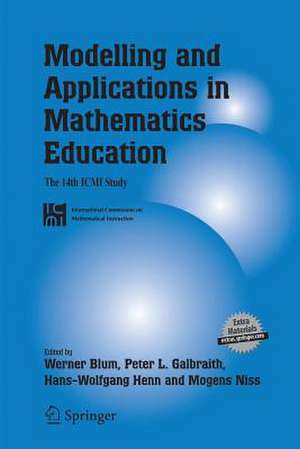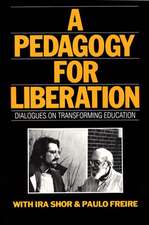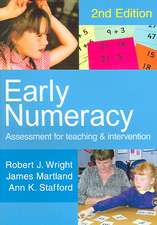Modelling and Applications in Mathematics Education: The 14th ICMI Study: New ICMI Study Series, cartea 10
Editat de Peter L. Galbraith, Hans-Wolfgang Henn, Mogens Nissen Limba Engleză Paperback – 20 sep 2014
| Toate formatele și edițiile | Preț | Express |
|---|---|---|
| Paperback (1) | 574.38 lei 38-44 zile | |
| Springer Us – 20 sep 2014 | 574.38 lei 38-44 zile | |
| Mixed media product (1) | 961.23 lei 6-8 săpt. | |
| Springer Us – 4 dec 2006 | 961.23 lei 6-8 săpt. |
Din seria New ICMI Study Series
-
 Preț: 443.10 lei
Preț: 443.10 lei -
 Preț: 399.29 lei
Preț: 399.29 lei -
 Preț: 398.15 lei
Preț: 398.15 lei -
 Preț: 411.64 lei
Preț: 411.64 lei - 15%
 Preț: 644.63 lei
Preț: 644.63 lei - 15%
 Preț: 646.43 lei
Preț: 646.43 lei - 18%
 Preț: 951.47 lei
Preț: 951.47 lei - 18%
 Preț: 1226.73 lei
Preț: 1226.73 lei - 18%
 Preț: 951.47 lei
Preț: 951.47 lei -
 Preț: 332.70 lei
Preț: 332.70 lei - 15%
 Preț: 653.98 lei
Preț: 653.98 lei - 15%
 Preț: 646.43 lei
Preț: 646.43 lei - 18%
 Preț: 951.91 lei
Preț: 951.91 lei - 18%
 Preț: 1244.59 lei
Preț: 1244.59 lei -
 Preț: 405.06 lei
Preț: 405.06 lei - 18%
 Preț: 947.85 lei
Preț: 947.85 lei - 18%
 Preț: 955.40 lei
Preț: 955.40 lei - 18%
 Preț: 1396.74 lei
Preț: 1396.74 lei - 18%
 Preț: 955.08 lei
Preț: 955.08 lei - 18%
 Preț: 1238.23 lei
Preț: 1238.23 lei
Preț: 574.38 lei
Preț vechi: 709.12 lei
-19% Nou
Puncte Express: 862
Preț estimativ în valută:
109.92€ • 114.11$ • 91.66£
109.92€ • 114.11$ • 91.66£
Carte tipărită la comandă
Livrare economică 21-27 martie
Preluare comenzi: 021 569.72.76
Specificații
ISBN-13: 9781489992499
ISBN-10: 1489992499
Pagini: 524
Ilustrații: XIV, 523 p.
Dimensiuni: 155 x 235 x 28 mm
Greutate: 0.75 kg
Ediția:2007
Editura: Springer Us
Colecția Springer
Seria New ICMI Study Series
Locul publicării:New York, NY, United States
ISBN-10: 1489992499
Pagini: 524
Ilustrații: XIV, 523 p.
Dimensiuni: 155 x 235 x 28 mm
Greutate: 0.75 kg
Ediția:2007
Editura: Springer Us
Colecția Springer
Seria New ICMI Study Series
Locul publicării:New York, NY, United States
Public țintă
Professional/practitionerCuprins
Plenaries.- Less Chalk, Less Words, Less Symbols ... More Objects, More Context, More Actions.- What’s all the Fuss about Competencies?.- A Theory of Mathematical Modelling in Technological Settings.- What Knowledge Do Teachers Need for Teaching Mathematics Through Applications and Modelling?.- Beyond the Low Hanging Fruit.- Modelling for Life: Mathematics and Children’s Experience.- Modelling in Lower Secondary Mathematics Classroom — Problems and Opportunities.- Mathematical Modelling — a Conversation with Henry Pollak.- Issues in Applications and Modelling.- Epistemology and Modelling — Overview.- Modelling Body Motion: an Approach to Functions Using Measuring Instruments.- Emergent Modelling as a Precursor to Mathematical Modelling.- Proving and Modelling.- A Developmental Approach for Supporting the Epistemology of Modeling.- What is Distinctive in (Our Views about) Models & Modelling Perspectives on Mathematics Problem Solving, Learning, and Teaching?.- Everyday Instruments: On the Use of Mathematics.- Authenticity and Goals — Overview.- How to Replace Word Problems with Activities of Realistic Mathematical Modelling.- The Relevance of Modelling and Applications: Relevant to Whom and for What Purpose?.- Features and Impact of the Authenticity of Applied Mathematical School Tasks.- Elementary Modelling in Mathematics Lessons: The Interplay Between “Real-World” Knowledge and “Mathematical Structures”.- Modelling Competencies — Overview.- Levels of Modelling Competencies.- Modelling Both Complexity and Abstraction: A Paradox?.- Studying and Remedying Students’ Modelling Competencies: Routine Behaviour or Adaptive Expertise.- Assessing the “Phases” of Mathematical Modelling.- The Arithmetic Operations as Mathematical Models.- Applicationsand Modelling for Mathematics — Overview.- The Roles of Modelling in Learning Mathematics.- Developing Mathematical Literacy.- Classroom Activities and the Teacher.- Uses of Technologies in Learning Mathematics through Modelling.- Modelling Pedagogy — Overview.- Mathematical Modelling in High School Mathematics: Teachers’ Thinking and Practice.- Mathematical Modelling in Teacher Education — Necessity or Unnecessarily.- Building Concepts and Conceptions in Technology-Based Open Learning Environments.- Towards a Wider Implementation of Mathematical Modelling at Upper Secondary and Tertiary Levels.- How Might we Share Models Through Cooperative Mathematical Modelling? Focus on Situations Based on Individual Experiences.- Implementation and Practice — Overview.- Some Conditions for Modelling to Exist in Mathematics Classrooms.- Picture (Im)Perfect Mathematics!.- Learning Mathematical Modelling — From the Perspective of Probability and Statistics Education.- Considering Workplace Activity from a Mathematical Modelling Perspective.- Assessment and Evaluation - Overview.- Modelling Based Project Examination.- Mathematical Modelling and Applications: Ability and Competence Frameworks.- “To Model, or to Let Them Model?” That is the Question!.- Modelling and Applications in Pisa.- Assessment of Applied Mathematics and Modelling: Using a Laboratory-Like Environment.- Educational Levels.- Modelling and Applications in Primary Education.- Possibilities for, and Obstacles to Teaching Applications and Modelling in the Lower Secondary Levels.- Upper Secondary Perspectives on Applications and Modelling.- Teaching Applications and Modelling at Tertiary Level.- Modelling in Teacher Education.- Cases in Applications and Modelling.- Moving the Context of Modelling to theForefront: Preservice Teachers’ Investigations of Equity in Testing.- Modelling in Ontario: Success in Moving Along the Continuum.- Implementation Case Study: Sustaining Curriculum Change.- Mathematical Modelling of Social Issues in School Mathematics in South Africa.
Textul de pe ultima copertă
The overall goal of Modelling and Applications in Mathematics Education is to provide a comprehensive overview of the state-of-the-art in the field of modelling and applications in mathematics education. Key issues are dealt with, among which are the following:
Epistemology and the relationships between mathematics and the "rest of the world"; the meaning of mathematical modelling and its process components; the respect in which the distinction between pure mathematics and applications of mathematics make sense
Authenticity and Goals dealing with modelling and applications in mathematics teaching; appropriate balance between modelling activities and other mathematical activities; the role that authentic problem situations play in modelling and applications activities
Modelling Competencies: characterizing how a student's modelling competency can be characterized; identifiable sub-competencies, and the ways they constitute a general modelling competency; developing competency over time
Mathematical Competencies: identifying the most important mathematical competencies that students should acquire, and how modelling and applications activities can contribute toward building up these competencies; the meaning of "Mathematical Literacy" in relation to modelling
Modelling Pedagogy: appropriate pedagogical principles and strategies for the development of modelling courses and their teaching; the role of technology in the teaching of modelling and applications
Implementation and Practice: the role of modelling and applications in everyday mathematics teaching; major impediments and obstacles; advancing the use of modelling examples in everyday classrooms; documenting successful implementation of modelling in mathematics teaching
Assessment and Evaluation: assessment modes that capture the essential components of modelling competency; modes available for modelling and applications courses and curricula; appropriate strategies to implement new assessment and evaluation modes in practice
The contributing authors are eminent members of the mathematics education community. Modelling and Applications in Mathematics Education will be of special interest to mathematics educators, teacher educators, researchers, education administrators, curriculum developers and student teachers.
Epistemology and the relationships between mathematics and the "rest of the world"; the meaning of mathematical modelling and its process components; the respect in which the distinction between pure mathematics and applications of mathematics make sense
Authenticity and Goals dealing with modelling and applications in mathematics teaching; appropriate balance between modelling activities and other mathematical activities; the role that authentic problem situations play in modelling and applications activities
Modelling Competencies: characterizing how a student's modelling competency can be characterized; identifiable sub-competencies, and the ways they constitute a general modelling competency; developing competency over time
Mathematical Competencies: identifying the most important mathematical competencies that students should acquire, and how modelling and applications activities can contribute toward building up these competencies; the meaning of "Mathematical Literacy" in relation to modelling
Modelling Pedagogy: appropriate pedagogical principles and strategies for the development of modelling courses and their teaching; the role of technology in the teaching of modelling and applications
Implementation and Practice: the role of modelling and applications in everyday mathematics teaching; major impediments and obstacles; advancing the use of modelling examples in everyday classrooms; documenting successful implementation of modelling in mathematics teaching
Assessment and Evaluation: assessment modes that capture the essential components of modelling competency; modes available for modelling and applications courses and curricula; appropriate strategies to implement new assessment and evaluation modes in practice
The contributing authors are eminent members of the mathematics education community. Modelling and Applications in Mathematics Education will be of special interest to mathematics educators, teacher educators, researchers, education administrators, curriculum developers and student teachers.
Caracteristici
First volume that summarises the state-of-the art in the field of modelling and application in mathematics education Deals with the question of how key competencies of applications and modelling, at the heart of mathematical literacy, may be developed; with the roles that applications and modelling may play in mathematics teaching, making mathematics more relevant for students Summarises recent research findings in the field of knowledge about the human learning of mathematics Includes supplementary material: sn.pub/extras








